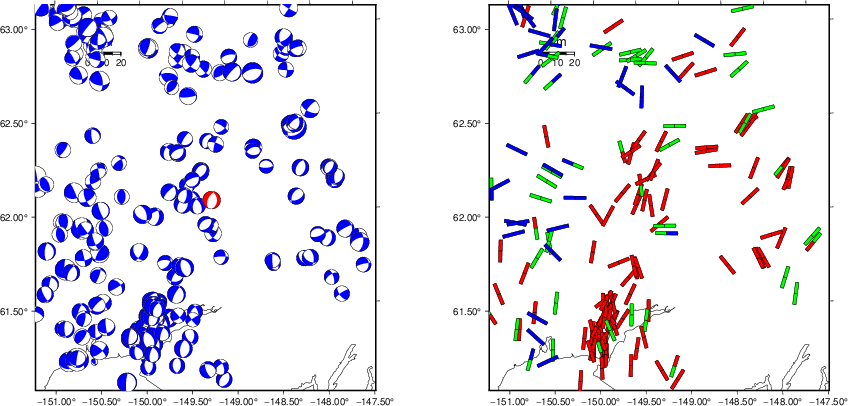Location
Location ANSS
The ANSS event ID is ak0258ve2yvm and the event page is at
https://earthquake.usgs.gov/earthquakes/eventpage/ak0258ve2yvm/executive.
2025/07/12 12:36:33 62.077 -149.227 25.4 4.5 Alaska
Focal Mechanism
USGS/SLU Moment Tensor Solution
ENS 2025/07/12 12:36:33.0 62.08 -149.23 25.4 4.5 Alaska
Stations used:
AK.BAE AK.BPAW AK.CAST AK.DHY AK.DIV AK.FID AK.FIRE AK.GHO
AK.HDA AK.HIN AK.K24K AK.KLU AK.KNK AK.L22K AK.M20K AK.PAX
AK.PPLA AK.PWL AK.RND AK.SAW AK.SCM AK.SKN AK.SLK AK.WAT6
AT.PMR AV.RED AV.SPCL AV.STLK
Filtering commands used:
cut o DIST/3.4 -40 o DIST/3.4 +50
rtr
taper w 0.1
hp c 0.03 n 3
lp c 0.10 n 3
Best Fitting Double Couple
Mo = 5.01e+22 dyne-cm
Mw = 4.40
Z = 50 km
Plane Strike Dip Rake
NP1 205 55 -75
NP2 360 38 -110
Principal Axes:
Axis Value Plunge Azimuth
T 5.01e+22 9 284
N 0.00e+00 12 16
P -5.01e+22 75 159
Moment Tensor: (dyne-cm)
Component Value
Mxx -1.48e+19
Mxy -1.06e+22
Mxz 1.37e+22
Myy 4.55e+22
Myz -1.19e+22
Mzz -4.55e+22
##########----
######################
################-----#######
##############----------######
##############-------------#######
##############---------------#######
##############-----------------#######
##########-------------------########
T #########---------------------#######
# #########---------------------########
############----------------------########
###########-----------------------########
###########---------- ----------########
#########----------- P ----------#######
#########----------- ---------########
########-----------------------#######
#######----------------------#######
######---------------------#######
####--------------------######
####-----------------#######
##--------------######
----------####
Global CMT Convention Moment Tensor:
R T P
-4.55e+22 1.37e+22 1.19e+22
1.37e+22 -1.48e+19 1.06e+22
1.19e+22 1.06e+22 4.55e+22
Details of the solution is found at
http://www.eas.slu.edu/eqc/eqc_mt/MECH.NA/20250712123633/index.html
|
Preferred Solution
The preferred solution from an analysis of the surface-wave spectral amplitude radiation pattern, waveform inversion or first motion observations is
STK = 205
DIP = 55
RAKE = -75
MW = 4.40
HS = 50.0
The NDK file is 20250712123633.ndk
The waveform inversion is preferred.
Moment Tensor Comparison
The following compares this source inversion to those provided by others. The purpose is to look for major differences and also to note slight differences that might be inherent to the processing procedure. For completeness the USGS/SLU solution is repeated from above.
| SLU |
USGSMWR |
USGS/SLU Moment Tensor Solution
ENS 2025/07/12 12:36:33.0 62.08 -149.23 25.4 4.5 Alaska
Stations used:
AK.BAE AK.BPAW AK.CAST AK.DHY AK.DIV AK.FID AK.FIRE AK.GHO
AK.HDA AK.HIN AK.K24K AK.KLU AK.KNK AK.L22K AK.M20K AK.PAX
AK.PPLA AK.PWL AK.RND AK.SAW AK.SCM AK.SKN AK.SLK AK.WAT6
AT.PMR AV.RED AV.SPCL AV.STLK
Filtering commands used:
cut o DIST/3.4 -40 o DIST/3.4 +50
rtr
taper w 0.1
hp c 0.03 n 3
lp c 0.10 n 3
Best Fitting Double Couple
Mo = 5.01e+22 dyne-cm
Mw = 4.40
Z = 50 km
Plane Strike Dip Rake
NP1 205 55 -75
NP2 360 38 -110
Principal Axes:
Axis Value Plunge Azimuth
T 5.01e+22 9 284
N 0.00e+00 12 16
P -5.01e+22 75 159
Moment Tensor: (dyne-cm)
Component Value
Mxx -1.48e+19
Mxy -1.06e+22
Mxz 1.37e+22
Myy 4.55e+22
Myz -1.19e+22
Mzz -4.55e+22
##########----
######################
################-----#######
##############----------######
##############-------------#######
##############---------------#######
##############-----------------#######
##########-------------------########
T #########---------------------#######
# #########---------------------########
############----------------------########
###########-----------------------########
###########---------- ----------########
#########----------- P ----------#######
#########----------- ---------########
########-----------------------#######
#######----------------------#######
######---------------------#######
####--------------------######
####-----------------#######
##--------------######
----------####
Global CMT Convention Moment Tensor:
R T P
-4.55e+22 1.37e+22 1.19e+22
1.37e+22 -1.48e+19 1.06e+22
1.19e+22 1.06e+22 4.55e+22
Details of the solution is found at
http://www.eas.slu.edu/eqc/eqc_mt/MECH.NA/20250712123633/index.html
|
Regional Moment Tensor (Mwr)
Moment
5.804e+15 N-m
Magnitude
4.44 Mwr
Depth
51.0 km
Percent DC
99%
Half Duration
-
Catalog
US
Data Source
US
Contributor
US
Nodal Planes
Plane Strike Dip Rake
NP1 356 37 -117
NP2 208 57 -71
Principal Axes
Axis Value Plunge Azimuth
T 5.818e+15 10 285
N -0.028e+15 16 18
P -5.791e+15 71 162
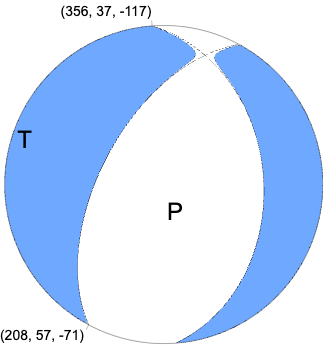
|
Magnitudes
Given the availability of digital waveforms for determination of the moment tensor, this section documents the added processing leading to mLg, if appropriate to the region, and ML by application of the respective IASPEI formulae. As a research study, the linear distance term of the IASPEI formula
for ML is adjusted to remove a linear distance trend in residuals to give a regionally defined ML. The defined ML uses horizontal component recordings, but the same procedure is applied to the vertical components since there may be some interest in vertical component ground motions. Residual plots versus distance may indicate interesting features of ground motion scaling in some distance ranges. A residual plot of the regionalized magnitude is given as a function of distance and azimuth, since data sets may transcend different wave propagation provinces.
ML Magnitude

Left: ML computed using the IASPEI formula for Horizontal components. Center: ML residuals computed using a modified IASPEI formula that accounts for path specific attenuation; the values used for the trimmed mean are indicated. The ML relation used for each figure is given at the bottom of each plot.
Right: Residuals from new relation as a function of distance and azimuth.

Left: ML computed using the IASPEI formula for Vertical components (research). Center: ML residuals computed using a modified IASPEI formula that accounts for path specific attenuation; the values used for the trimmed mean are indicated. The ML relation used for each figure is given at the bottom of each plot.
Right: Residuals from new relation as a function of distance and azimuth.
Context
The left panel of the next figure presents the focal mechanism for this earthquake (red) in the context of other nearby events (blue) in the SLU Moment Tensor Catalog. The right panel shows the inferred direction of maximum compressive stress and the type of faulting (green is strike-slip, red is normal, blue is thrust; oblique is shown by a combination of colors). Thus context plot is useful for assessing the appropriateness of the moment tensor of this event.
Waveform Inversion using wvfgrd96
The focal mechanism was determined using broadband seismic waveforms. The location of the event (star) and the
stations used for (red) the waveform inversion are shown in the next figure.
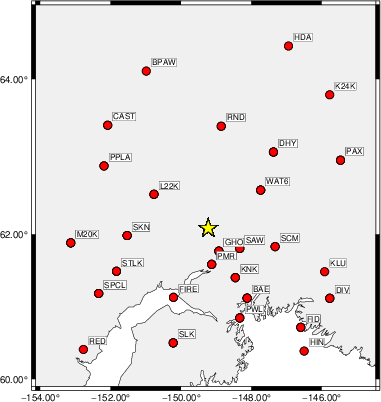
|
|
Location of broadband stations used for waveform inversion
|
The program wvfgrd96 was used with good traces observed at short distance to determine the focal mechanism, depth and seismic moment. This technique requires a high quality signal and well determined velocity model for the Green's functions. To the extent that these are the quality data, this type of mechanism should be preferred over the radiation pattern technique which requires the separate step of defining the pressure and tension quadrants and the correct strike.
The observed and predicted traces are filtered using the following gsac commands:
cut o DIST/3.4 -40 o DIST/3.4 +50
rtr
taper w 0.1
hp c 0.03 n 3
lp c 0.10 n 3
The results of this grid search are as follow:
DEPTH STK DIP RAKE MW FIT
WVFGRD96 1.0 20 45 90 3.50 0.1694
WVFGRD96 2.0 15 45 85 3.65 0.2233
WVFGRD96 3.0 5 50 75 3.70 0.2176
WVFGRD96 4.0 330 40 -5 3.67 0.2377
WVFGRD96 5.0 325 45 -15 3.70 0.2605
WVFGRD96 6.0 335 45 20 3.72 0.2768
WVFGRD96 7.0 340 45 25 3.75 0.2978
WVFGRD96 8.0 345 40 35 3.82 0.3113
WVFGRD96 9.0 340 45 30 3.84 0.3250
WVFGRD96 10.0 340 45 30 3.86 0.3342
WVFGRD96 11.0 340 45 30 3.87 0.3389
WVFGRD96 12.0 340 45 30 3.89 0.3404
WVFGRD96 13.0 340 45 35 3.90 0.3392
WVFGRD96 14.0 250 65 45 3.92 0.3429
WVFGRD96 15.0 250 65 45 3.93 0.3435
WVFGRD96 16.0 250 65 45 3.95 0.3436
WVFGRD96 17.0 250 65 40 3.96 0.3439
WVFGRD96 18.0 250 65 40 3.98 0.3446
WVFGRD96 19.0 250 65 40 3.99 0.3444
WVFGRD96 20.0 230 65 -35 4.01 0.3502
WVFGRD96 21.0 230 65 -35 4.03 0.3563
WVFGRD96 22.0 230 65 -35 4.04 0.3601
WVFGRD96 23.0 230 65 -35 4.05 0.3635
WVFGRD96 24.0 230 70 -35 4.06 0.3651
WVFGRD96 25.0 230 70 -35 4.07 0.3670
WVFGRD96 26.0 230 70 -35 4.08 0.3674
WVFGRD96 27.0 230 70 -35 4.09 0.3687
WVFGRD96 28.0 230 80 -40 4.09 0.3699
WVFGRD96 29.0 230 80 -40 4.10 0.3743
WVFGRD96 30.0 225 75 -40 4.12 0.3805
WVFGRD96 31.0 45 55 -45 4.11 0.3919
WVFGRD96 32.0 40 50 -55 4.12 0.4067
WVFGRD96 33.0 45 50 -50 4.13 0.4223
WVFGRD96 34.0 40 50 -55 4.14 0.4367
WVFGRD96 35.0 35 45 -60 4.15 0.4522
WVFGRD96 36.0 35 45 -65 4.16 0.4630
WVFGRD96 37.0 35 45 -65 4.17 0.4723
WVFGRD96 38.0 20 35 -80 4.19 0.4831
WVFGRD96 39.0 15 35 -85 4.21 0.4933
WVFGRD96 40.0 15 35 -90 4.30 0.5248
WVFGRD96 41.0 195 55 -90 4.32 0.5333
WVFGRD96 42.0 195 55 -90 4.33 0.5395
WVFGRD96 43.0 195 55 -90 4.34 0.5442
WVFGRD96 44.0 200 55 -85 4.36 0.5491
WVFGRD96 45.0 200 55 -80 4.37 0.5539
WVFGRD96 46.0 200 55 -80 4.38 0.5561
WVFGRD96 47.0 205 55 -75 4.39 0.5590
WVFGRD96 48.0 205 55 -75 4.39 0.5611
WVFGRD96 49.0 205 55 -75 4.40 0.5622
WVFGRD96 50.0 205 55 -75 4.40 0.5626
WVFGRD96 51.0 205 55 -75 4.41 0.5607
WVFGRD96 52.0 205 55 -75 4.41 0.5588
WVFGRD96 53.0 205 55 -75 4.41 0.5549
WVFGRD96 54.0 205 55 -75 4.41 0.5526
WVFGRD96 55.0 205 55 -75 4.41 0.5477
WVFGRD96 56.0 205 55 -75 4.41 0.5432
WVFGRD96 57.0 205 55 -75 4.41 0.5381
WVFGRD96 58.0 205 55 -75 4.41 0.5327
WVFGRD96 59.0 205 55 -75 4.41 0.5277
The best solution is
WVFGRD96 50.0 205 55 -75 4.40 0.5626
The mechanism corresponding to the best fit is
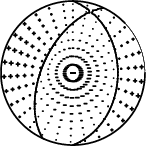
|
|
Figure 1. Waveform inversion focal mechanism
|
The best fit as a function of depth is given in the following figure:
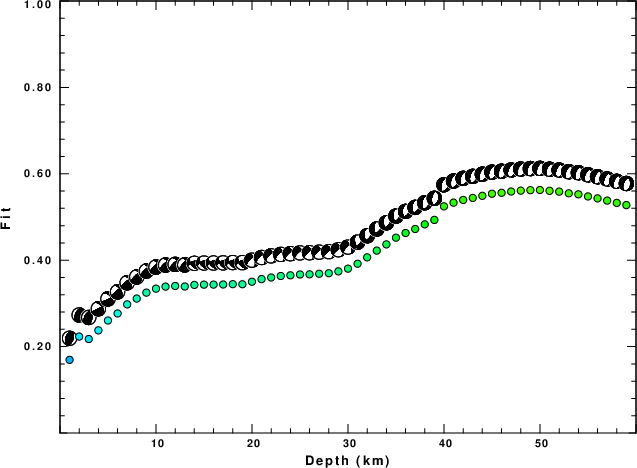
|
|
Figure 2. Depth sensitivity for waveform mechanism
|
The comparison of the observed and predicted waveforms is given in the next figure. The red traces are the observed and the blue are the predicted.
Each observed-predicted component is plotted to the same scale and peak amplitudes are indicated by the numbers to the left of each trace. A pair of numbers is given in black at the right of each predicted traces. The upper number it the time shift required for maximum correlation between the observed and predicted traces. This time shift is required because the synthetics are not computed at exactly the same distance as the observed, the velocity model used in the predictions may not be perfect and the epicentral parameters may be be off.
A positive time shift indicates that the prediction is too fast and should be delayed to match the observed trace (shift to the right in this figure). A negative value indicates that the prediction is too slow. The lower number gives the percentage of variance reduction to characterize the individual goodness of fit (100% indicates a perfect fit).
The bandpass filter used in the processing and for the display was
cut o DIST/3.4 -40 o DIST/3.4 +50
rtr
taper w 0.1
hp c 0.03 n 3
lp c 0.10 n 3

|
|
Figure 3. Waveform comparison for selected depth. Red: observed; Blue - predicted. The time shift with respect to the model prediction is indicated. The percent of fit is also indicated. The time scale is relative to the first trace sample.
|
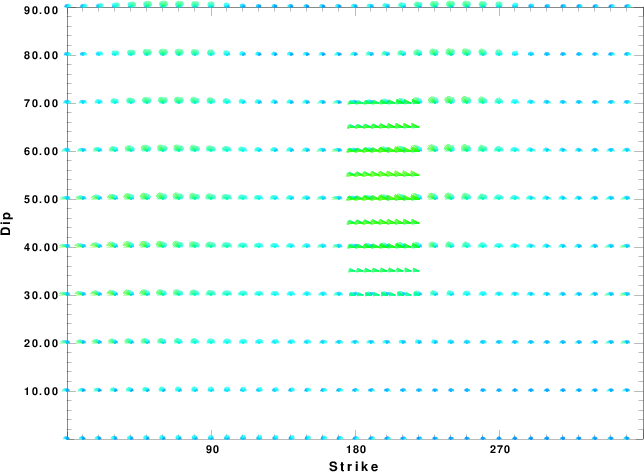
|
|
Focal mechanism sensitivity at the preferred depth. The red color indicates a very good fit to the waveforms.
Each solution is plotted as a vector at a given value of strike and dip with the angle of the vector representing the rake angle, measured, with respect to the upward vertical (N) in the figure.
|
A check on the assumed source location is possible by looking at the time shifts between the observed and predicted traces. The time shifts for waveform matching arise for several reasons:
- The origin time and epicentral distance are incorrect
- The velocity model used for the inversion is incorrect
- The velocity model used to define the P-arrival time is not the
same as the velocity model used for the waveform inversion
(assuming that the initial trace alignment is based on the
P arrival time)
Assuming only a mislocation, the time shifts are fit to a functional form:
Time_shift = A + B cos Azimuth + C Sin Azimuth
The time shifts for this inversion lead to the next figure:
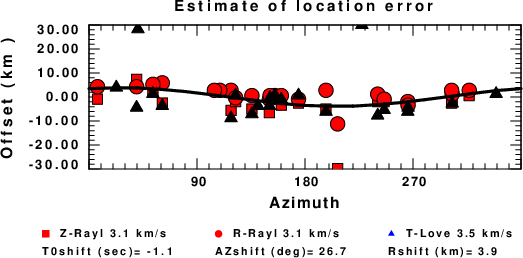
The derived shift in origin time and epicentral coordinates are given at the bottom of the figure.
Velocity Model
The WUS.model used for the waveform synthetic seismograms and for the surface wave eigenfunctions and dispersion is as follows
(The format is in the model96 format of Computer Programs in Seismology).
MODEL.01
Model after 8 iterations
ISOTROPIC
KGS
FLAT EARTH
1-D
CONSTANT VELOCITY
LINE08
LINE09
LINE10
LINE11
H(KM) VP(KM/S) VS(KM/S) RHO(GM/CC) QP QS ETAP ETAS FREFP FREFS
1.9000 3.4065 2.0089 2.2150 0.302E-02 0.679E-02 0.00 0.00 1.00 1.00
6.1000 5.5445 3.2953 2.6089 0.349E-02 0.784E-02 0.00 0.00 1.00 1.00
13.0000 6.2708 3.7396 2.7812 0.212E-02 0.476E-02 0.00 0.00 1.00 1.00
19.0000 6.4075 3.7680 2.8223 0.111E-02 0.249E-02 0.00 0.00 1.00 1.00
0.0000 7.9000 4.6200 3.2760 0.164E-10 0.370E-10 0.00 0.00 1.00 1.00
Last Changed Sat Jul 12 09:44:21 CDT 2025



